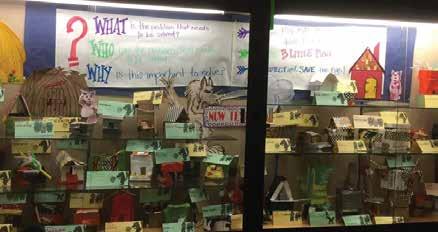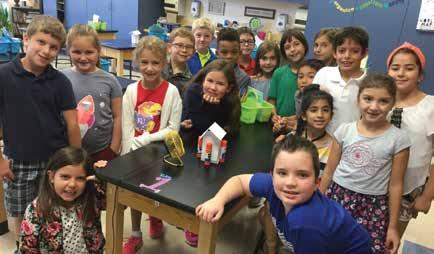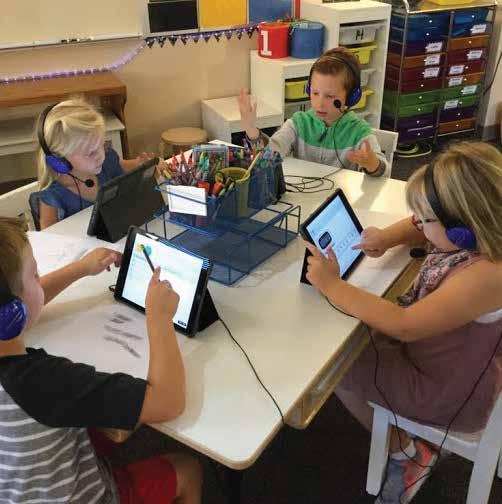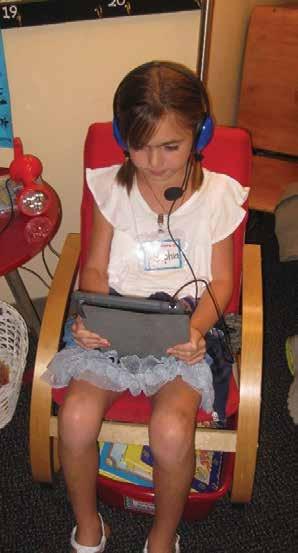
3 minute read
Where We're Going: A Look Inside the Classroom
WHERE WE'RE GOING YOUNG ENGINEERS
// Sherri Newlin, Lower School Science Teacher
The Lower School started our engineering unit by reading The Three Little Pigs and discussing how and why certain houses survived the Big Bad Wolf and others did not. In students’ first challenge of the unit, they had a day of free exploration to design and build houses out of Legos, Ello, and wooden blocks. Once houses were built, the first “Big Bad Wolf” (me, Mrs. Newlin) came and tried to blow them down. Students loved discussing how certain materials aided themselves in being sturdier and how certain design components made a house strong and safe. Subsequent classes focused on the base/foundation of the house and the fact that, when designing something, the purpose of the project, the materials used, and the tools available must be considered. To show an example of this, we built uniform houses out of index cards in a second challenge and had another “Big Bad Wolf” (a fan) visit. When none of those houses survived, I sent them back to make improvements that could withstand more huffing and puffing. Students’ third challenge was to design and build their own original structure out of recycled materials. I set size and scale parameters and a sample pig that needed to fit in the house before we began the project. Students had to draw plans for their ideas before construction started. We tested the structures with the third “Big Bad Wolf” (a hair dryer). Despite end results for any of the challenges, one of the most valuable lessons learned was that you must try things over and over to get them right.




CONNECTING PARENTS AND TEACHERS
// Shirley Meissner, Second Grade Teacher
Educational practices continue to morph and change with the addition of technology in our school. Three years ago, our classrooms expanded with the addition of 1:1 iPads from first to fourth grades. This presented a new set of challenges for the students, teachers, and parents. How would we measure the learning with this new technology in our students’ hands every day? Teachers used to collect and save student work samples in a portfolio to present to their families at conference time. This was beneficial to see the student work, however the time frame for sharing projects and the ability to reteach concepts was delayed due to the handling of mountains of paperwork. Then, the SeeSaw app was discovered by one of our teachers and the opportunities it presented seemed to answer many of our questions and solve many of our problems. Students now have a digital portfolio of work they complete daily with family access immediately on any device. For example: students sort their words in the “Words Their Way” program, publish it on their Seesaw portfolio, and receive a written or voice response about their work from the teacher and a response from their parents, all in a matter of minutes. Students present their book reports in class while being filmed and their grandparents across the country have access to the video just moments after the live performance. The SeeSaw app is available to family members who see only their student’s work – a safe way to share on the World Wide Web. Several of our families who travel for work out of town, state, or country can check on their student and the work he or she is posting daily to the portfolio, allowing a personal connection not available in the past. Walk through the Lower School building any time of day and you will see students using their iPads and SeeSaw to: read aloud on their portfolio, complete math journal pages, sort their words, scan QR codes to show Early Childhood friends their Native American Art projects, work together in solving scavenger hunts to take students to places around the world, and complete activities that show technology skills in action using curriculum as their guide. You will also see parents using their phones to scan items on display in the hallways where students have recorded themselves sharing how they created each item. The SeeSaw app has revolutionized how students interact with their curriculum, and allowed parents an authentic peek into what the students are doing in the classroom during real time.










